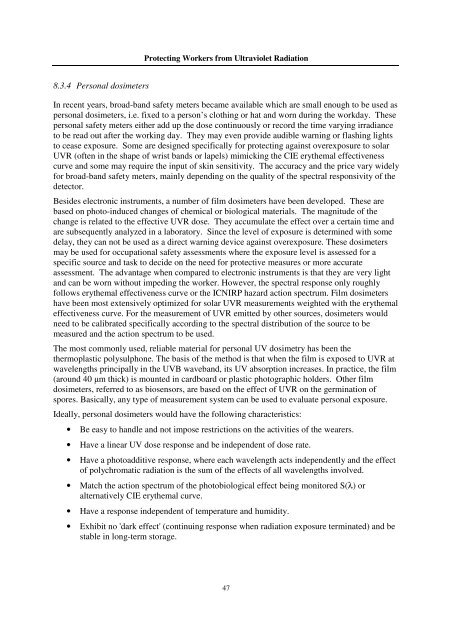Protecting Workers from Ultraviolet Radiation - icnirp
Protecting Workers from Ultraviolet Radiation - icnirp
Protecting Workers from Ultraviolet Radiation - icnirp
Create successful ePaper yourself
Turn your PDF publications into a flip-book with our unique Google optimized e-Paper software.
8.3.4 Personal dosimeters<br />
<strong>Protecting</strong> <strong>Workers</strong> <strong>from</strong> <strong>Ultraviolet</strong> <strong>Radiation</strong><br />
In recent years, broad-band safety meters became available which are small enough to be used as<br />
personal dosimeters, i.e. fixed to a person’s clothing or hat and worn during the workday. These<br />
personal safety meters either add up the dose continuously or record the time varying irradiance<br />
to be read out after the working day. They may even provide audible warning or flashing lights<br />
to cease exposure. Some are designed specifically for protecting against overexposure to solar<br />
UVR (often in the shape of wrist bands or lapels) mimicking the CIE erythemal effectiveness<br />
curve and some may require the input of skin sensitivity. The accuracy and the price vary widely<br />
for broad-band safety meters, mainly depending on the quality of the spectral responsivity of the<br />
detector.<br />
Besides electronic instruments, a number of film dosimeters have been developed. These are<br />
based on photo-induced changes of chemical or biological materials. The magnitude of the<br />
change is related to the effective UVR dose. They accumulate the effect over a certain time and<br />
are subsequently analyzed in a laboratory. Since the level of exposure is determined with some<br />
delay, they can not be used as a direct warning device against overexposure. These dosimeters<br />
may be used for occupational safety assessments where the exposure level is assessed for a<br />
specific source and task to decide on the need for protective measures or more accurate<br />
assessment. The advantage when compared to electronic instruments is that they are very light<br />
and can be worn without impeding the worker. However, the spectral response only roughly<br />
follows erythemal effectiveness curve or the ICNIRP hazard action spectrum. Film dosimeters<br />
have been most extensively optimized for solar UVR measurements weighted with the erythemal<br />
effectiveness curve. For the measurement of UVR emitted by other sources, dosimeters would<br />
need to be calibrated specifically according to the spectral distribution of the source to be<br />
measured and the action spectrum to be used.<br />
The most commonly used, reliable material for personal UV dosimetry has been the<br />
thermoplastic polysulphone. The basis of the method is that when the film is exposed to UVR at<br />
wavelengths principally in the UVB waveband, its UV absorption increases. In practice, the film<br />
(around 40 m thick) is mounted in cardboard or plastic photographic holders. Other film<br />
dosimeters, referred to as biosensors, are based on the effect of UVR on the germination of<br />
spores. Basically, any type of measurement system can be used to evaluate personal exposure.<br />
Ideally, personal dosimeters would have the following characteristics:<br />
• Be easy to handle and not impose restrictions on the activities of the wearers.<br />
• Have a linear UV dose response and be independent of dose rate.<br />
• Have a photoadditive response, where each wavelength acts independently and the effect<br />
of polychromatic radiation is the sum of the effects of all wavelengths involved.<br />
• Match the action spectrum of the photobiological effect being monitored S(λ) or<br />
alternatively CIE erythemal curve.<br />
• Have a response independent of temperature and humidity.<br />
• Exhibit no 'dark effect' (continuing response when radiation exposure terminated) and be<br />
stable in long-term storage.<br />
47



